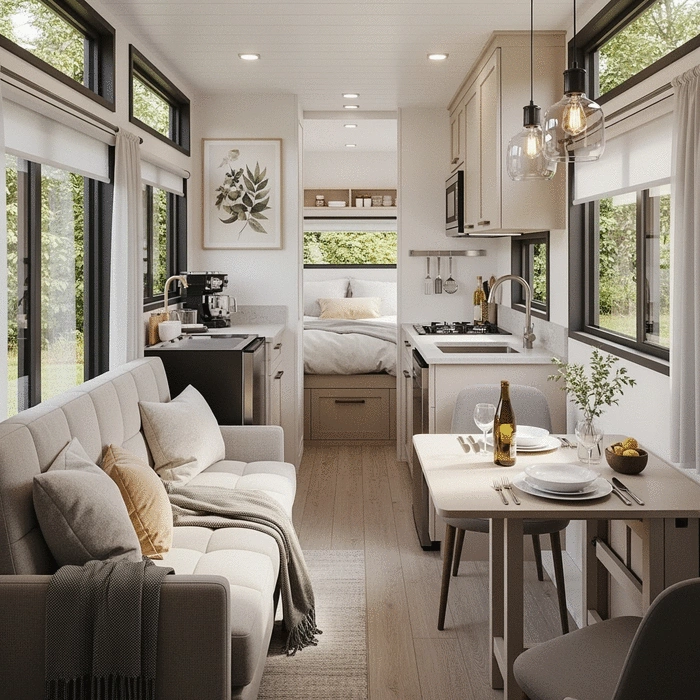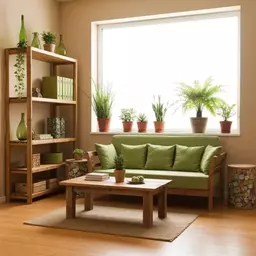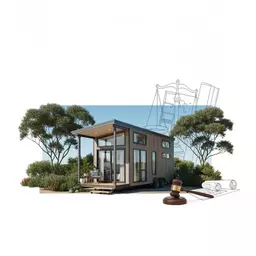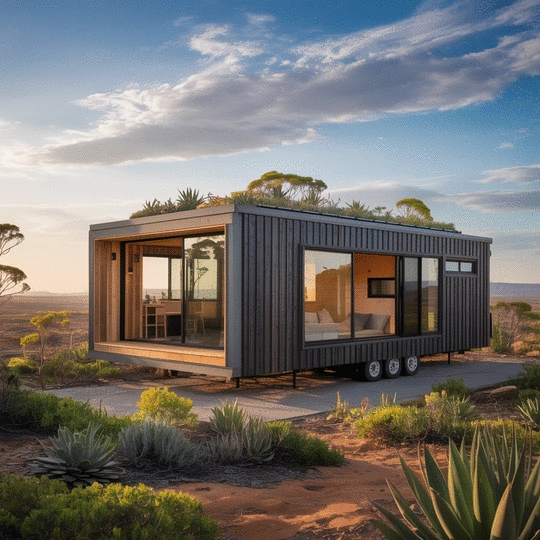Tiny House Design Ideas Simplified

Posted on: 2025-10-24
By: Sophie Marchant
What if you could live simply, with fewer possessions and more freedom? The tiny house movement has inspired countless individuals to rethink their living spaces and lifestyles, emphasizing sustainability, community, and creativity. Dive into this exciting journey and learn how innovative design can transform your life!
What You Will Learn
- Why tiny homes are appealing: affordability, simplicity, sustainability, and flexibility.
- The importance of innovative design in maximizing space and enhancing comfort.
- Effective storage solutions that help organize tiny living spaces efficiently.
- Benefits of multi-functional furniture for optimizing tiny home environments.
- The role of natural light and sustainable practices in creating inviting tiny homes.
- Steps to start your tiny house project, including defining goals and researching regulations.
- The value of engaging with the tiny house community for support and inspiration.
- Resources for further exploration, such as blogs and online courses dedicated to tiny living.
Innovative Strategies for Small Living Spaces
The following highlights key strategies that enhance the functionality and aesthetics of tiny homes through smart design features.
Effective Storage Solutions
- Under-bed storage
- Built-in shelving
- Wall-mounted organizers
- Multi-use furniture
Benefits of Multi-Functional Furniture
- Convertible sofas
- Foldable tables
- Murphy beds
Space-Saving Design Features
- Sliding doors
- Bespoke cabinetry
- Lofted beds
Maximizing Natural Light
Utilizing windows and skylights creates an inviting atmosphere and connects you with nature.
Creative Tiny House Design Concepts for Small Living
Embracing the tiny house movement isn't just about downsizing; it's about creatively maximizing our living spaces while enhancing our lifestyles. Tiny homes have become a popular choice for many, offering a unique blend of freedom, simplicity, and sustainability. At The Tiny Living Guide, we believe that innovative design concepts can transform how we view our living environments, making them more functional and enjoyable.
Understanding the Appeal of Tiny Homes
So, why are more people choosing tiny houses? For many, the allure lies in the promise of a simpler life, free from the burdens of large mortgages and extensive maintenance. Tiny homes foster a sense of community and connection, allowing individuals to prioritize experiences over possessions. If you’ve ever felt overwhelmed by the clutter of life, tiny living might just be the answer you’re looking for!
Why More People Are Choosing Tiny Houses
As we explore the rising trend of tiny living, several factors contribute to this shift. Here are some key reasons people are opting for tiny homes:
- Affordability: Tiny homes are generally more budget-friendly, allowing owners to live mortgage-free.
- Simplicity: The minimalist lifestyle encourages less stress and more focus on what truly matters.
- Sustainability: Smaller homes often use fewer resources, making them more environmentally friendly.
- Flexibility: Tiny houses can be moved easily, providing a sense of freedom and adventure.
The Benefits of Innovative Tiny House Designs
Innovative designs play a crucial role in the success of tiny homes. They allow us to optimize every square inch, making even the smallest spaces feel open and inviting. Here are some benefits that come with thoughtful design:
- Efficient use of space: Design strategies like multi-functional furniture create a seamless flow.
- Customization: Each tiny home can reflect the owner’s personality and lifestyle needs.
- Enhanced comfort: Thoughtful layouts promote a sense of well-being and tranquility.
Exploring the Tiny House Movement
The tiny house movement is about more than just downsizing; it's a lifestyle choice that champions sustainability and community. As I connect with other tiny home enthusiasts, I’m continually inspired by their stories. Each tiny house embodies the spirit of creativity and resilience, showcasing how innovative design can lead to fulfilling, debt-free living. Are you ready to explore this exciting journey?
Maximizing Space with Smart Design Features
Maximizing space in tiny homes is both an art and a science! With the right design features, we can transform compact areas into functional, inviting environments. Let's look at some key strategies that enhance small living spaces.
Effective Storage Solutions for Small Spaces
Storage is often a top concern for tiny house dwellers. Fortunately, there are numerous clever solutions to help you stay organized. Here are some effective storage ideas:
- Under-bed storage: Utilize the space beneath your bed for bins or drawers.
- Built-in shelving: Create custom shelves that fit your unique space.
- Wall-mounted organizers: Use vertical space for hooks and baskets.
- Multi-use furniture: Choose pieces that offer hidden storage, like ottomans or coffee tables.
Multi-Functional Furniture: A Key to Efficient Living
Multi-functional furniture is a game-changer in tiny house design. These pieces serve multiple purposes, saving valuable space while enhancing your lifestyle. Consider incorporating:
- Convertible sofas: A couch that can transform into a bed.
- Foldable tables: A dining table that can collapse when not in use.
- Murphy beds: Beds that fold up into the wall for extra floor space.
Space-Saving Furniture and Innovative Storage Solutions
As I explore tiny house designs, I’m always amazed by the creativity behind space-saving furniture. These innovative solutions not only maximize functionality but also add style to your home. Think about incorporating:
- Sliding doors: Save space by using doors that slide instead of swing open.
- Bespoke cabinetry: Custom cabinets tailored to your needs.
- Lofted beds: Elevate your bed to free up room for a desk or seating area below.
With these smart design features, tiny living can be both stylish and practical. In the next part, we’ll delve into how adaptable design elements can further enhance your tiny home experience. Are you excited to learn more? Let’s continue this journey together!
Pro Tip
When designing your tiny home, consider incorporating biophilic design elements. This approach focuses on connecting your living space with nature, which can enhance your well-being. Integrate natural materials, plants, and ample windows to bring the outside in and create a serene atmosphere.
Summarizing Key Insights on Tiny House Design
As we wrap up our exploration into tiny house design, it’s clear that there’s so much to discover! From enhancing space efficiency to embracing sustainable living, the tiny house movement offers innovative solutions for those looking to downsize and simplify their lives. I hope you've found inspiration in the various design concepts we've discussed and feel motivated to embark on your own tiny living journey!
Throughout this journey, we've highlighted several key strategies that can help you maximize your small living space. By implementing effective storage solutions, opting for multi-functional furniture, and embracing the power of natural light, you can create a comfortable and functional environment that reflects your values.
Recap of Innovative Strategies for Small Spaces
Let’s take a moment to revisit the innovative strategies that make tiny living a practical choice:
- Utilizing vertical space to maximize storage and create a sense of openness.
- Incorporating adaptable design concepts, such as Murphy beds and retractable walls.
- Designing with natural light in mind, featuring windows and skylights to brighten your space.
- Choosing sustainable materials and energy-efficient features to reduce your environmental footprint.
These strategies not only enhance the aesthetic appeal of your tiny home but also promote a lifestyle that values simplicity and efficiency. As the founder of The Tiny Living Guide, I'm passionate about helping you navigate these choices, ensuring your tiny home is both beautiful and functional!
Importance of Natural Light and Sustainable Practices
Natural light is essential in tiny homes. It creates an inviting atmosphere and makes the space feel larger. By incorporating windows and skylights, you can enhance your living experience and connect with nature. Additionally, embracing sustainable practices, such as using eco-friendly materials and energy-efficient appliances, contributes to a healthier planet and a happier you!
As you plan your tiny home, consider how these elements can be integrated into your design. This not only supports your personal goals but also aligns with the broader mission of The Tiny Living Guide, which aims to promote eco-friendly living among our community.
Understanding the Role of Minimalist Living in Tiny Homes
Minimalism is at the heart of tiny living. It encourages us to focus on what truly matters, helping to eliminate clutter and distractions. By embracing this mindset, you can create a serene environment that fosters peace and contentment. Remember, living simply doesn’t mean sacrificing comfort; rather, it’s about optimizing what you have!
Think about your priorities and lifestyle when designing your tiny home. What items are essential? What can you live without? This reflection will guide you in crafting a space that resonates with your values and supports your journey toward financial freedom.
Encouraging Action: Steps to Start Your Tiny House Project
Ready to take the plunge into tiny living? Here are some straightforward steps to guide you in kickstarting your tiny house project:
- Define your goals and vision for your tiny home.
- Research local zoning laws and regulations to ensure compliance. It's crucial to understand the legal framework governing tiny homes in your area, as regulations can vary significantly. You can also find information from organizations like the Tiny House Alliance USA, which clarifies how tiny homes are categorized as a housing type. For a comprehensive guide on what you need to know about tiny house zoning and regulations, various resources are available online.
- Connect with the tiny house community for support and inspiration.
- Start gathering design ideas and resources from blogs like The Tiny Living Guide!
- Consider DIY projects that can save money and personalize your space.
Starting this journey may feel overwhelming, but remember, every great adventure begins with a single step! Engage with fellow tiny house enthusiasts who share your passion—there’s a wealth of knowledge in our community just waiting to be explored.
Engaging with the Tiny House Community for Support
One of the most rewarding aspects of pursuing a tiny house lifestyle is connecting with others who share your vision. The tiny house community is known for its supportive spirit, offering advice, encouragement, and shared experiences. Joining local meetups, online forums, or social media groups can help you find like-minded individuals eager to share their insights.
At The Tiny Living Guide, we encourage you to engage actively. Share your journey, ask questions, and don’t hesitate to celebrate your milestones—no matter how small!
Exploring Tiny House Blogs and Online Courses for More Knowledge
As you dive into the tiny house movement, consider exploring various blogs and online courses dedicated to tiny living. These resources can provide practical tips, design inspiration, and valuable insights into building your dream home. Some excellent sources include:
- The Tiny Living Guide - for expert advice on sustainable living and tiny house design.
- Online courses focusing on construction techniques and design principles.
- Documentaries and podcasts featuring stories from other tiny house owners.
Engaging with these resources will help you build a deeper understanding of tiny living and empower you to create a home that truly reflects your aspirations. Let’s begin this incredible journey together and transform your dream of tiny living into a vibrant reality!
Frequently Asked Questions About Tiny House Living
- Q: What are the main benefits of living in a tiny house?
- A: Tiny homes offer several benefits, including affordability (often leading to a mortgage-free lifestyle), simplicity through minimalism, sustainability due to reduced resource consumption, and flexibility as many tiny homes are mobile.
- Q: How can I maximize space in a tiny house?
- A: Maximizing space in a tiny house involves innovative design strategies such as effective storage solutions (e.g., under-bed storage, built-in shelving, wall-mounted organizers), multi-functional furniture (e.g., convertible sofas, foldable tables, Murphy beds), and space-saving features (e.g., sliding doors, bespoke cabinetry, lofted beds).
- Q: What role does natural light play in tiny house design?
- A: Natural light is crucial in tiny homes as it creates an inviting atmosphere, makes the space feel larger, and connects occupants with nature. Utilizing windows and skylights significantly enhances the living experience.
- Q: Are there regulations I need to consider before building a tiny house?
- A: Yes, it is essential to research local zoning laws and regulations before starting your tiny house project. These regulations can vary significantly by location and will dictate where and how you can legally place or build your tiny home.
- Q: How can the tiny house community support new enthusiasts?
- A: The tiny house community is a valuable resource, offering support, advice, and shared experiences. Engaging with local meetups, online forums, and social media groups can provide inspiration and practical insights from like-minded individuals.
Recap of Key Points
Here is a quick recap of the important points discussed in the article:
- Affordability: Tiny homes offer a budget-friendly option, allowing for a mortgage-free lifestyle.
- Simplicity and Minimalism: Emphasizing a minimalist lifestyle reduces stress and focuses on experiences over possessions.
- Innovative Design: Utilizing multi-functional furniture and effective storage solutions maximizes space efficiency.
- Natural Light: Incorporating windows and skylights enhances the living experience and creates a more spacious feel.
- Sustainability: Choosing eco-friendly materials and energy-efficient features contributes to a healthier planet.
- Community Engagement: Connecting with the tiny house community provides support, inspiration, and shared experiences.
 What if your small living space could also be a sanctuary for the planet? Embracing sustainability n
What if your small living space could also be a sanctuary for the planet? Embracing sustainability n
 As the tiny home movement gains momentum in Australia, the legal landscape can feel daunting. Howeve
As the tiny home movement gains momentum in Australia, the legal landscape can feel daunting. Howeve
 Did you know that zoning laws can significantly impact the feasibility of sustainable housing initia
Did you know that zoning laws can significantly impact the feasibility of sustainable housing initia
